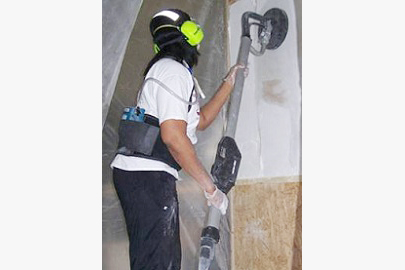Dust-control Usage: Strategic Technology Intervention (DUSTI)
Goals & Objectives
The goal of this project is to develop an intervention that will improve adoption of dust control technology in the drywall finishing sector of the construction industry. This exploratory project, which builds upon previous work of the principal investigators, incorporates elements from two well-established theoretical frameworks: Diffusion of Innovation Model and Health Belief Model.
Participant using a vent sander for drywall finishing

While the proposed exploratory project will develop and validate the intervention in this specific industry sector, the research has, as its ultimate aim, a transformative increase in the adoption of engineering control technologies among construction firms, industry-wide. Therefore, the intervention model design will incorporate factors applicable to generalized construction industry firms.
Project Approach & Activities
This Research-to-Practice (R2P) project, which builds upon the findings of the investigators’ previous work, will develop an intervention to improve adoption of engineering controls in the construction industry. The DUSTI intervention will, through education and marketing strategies, address key findings of previous studies that identified barriers to adoption and factors influencing diffusion of innovation in the construction industry.
The intervention will target three separate populations: workers, owners of small firms, and owners of large firms, since adoption barriers and diffusion characteristics were found to differ among these three groups. The worker intervention will employ “cues to action” and training aimed at health information, risks, and control technology. The small-firm intervention will employ the creation of “technology champions” within the firms and training aimed at productivity and customer satisfaction impacts, health information, and regulatory drivers. The large-firm intervention will involve information dissemination to purchasing agents aimed at communicating productivity and quality impacts, health information, and regulatory drivers.
A pretest-posttest, with control group, quasi-experimental design will be employed to evaluate the intervention impacts on key theoretical constructs and barriers to adoption among workers, small-firm owners, and large-firm purchasing agents. The primary study hypothesis is that the following constructs will be improved, post-intervention: health knowledge, perceived risk, worker self efficacy, organizational trust, trust in technology, adoption readiness, and perception of barriers.
Selected Outputs and Outcomes
- Weidman, J.E. (2012). Dust Control Usage: Strategic Technology Intervention. Published dissertation. Virginia Tech.
- Weidman, J.E.,Young-Corbett, D., Koebel, C.T., Fiori, C., and Montague, E.N. (2011). Prevention through Design: Use of the Diffusion of Innovation Model to Predict Adoption. International Council for Research and Innovation in Building and Construction Conference (CIB W099 Conference 2011), Washington, DC, USA.
- Ghosh, S., and Young-Corbett, D. (2011). Barriers to the Adoption of Prevention through Design (PtD) Controls among Masonry Workers. International Council for Research and Innovation in Building and Construction Conference (CIB W099 Conference 2011), Washington, DC, USA.
- Weidman, J.E., Dickerson, D.E. and Koebel, C.T. (2015). Prevention through Design Adoption Readiness Model (PtD ARM): An Integrated Conceptual Model. Work, 52(4): 865-876.
Faculty and Facility
PI: Deborah E. Young-Corbett, Ph.D.; Co-Investigator: C. Ted Koebel, Ph.D.
Occupational and Construction Hazard Reduction Engineering (OCHRE) Lab
Student Researchers
Weidman, J.; Laughead, J.; Otero, Y.; Ghosh, S.
Funding Source
"Dust control Usage: Strategic Technology Intervention (DUSTI)", NIOSH. (09/01/09 - 08/31/12) PI: D. E. Young-Corbett. Subproject within U60 OH 009761 (PI: Kleiner).
Sector: Construction
Discipline: Industrial Hygiene
PI: Deborah Young-Corbett (Virginia Tech)
Co-I: Ted Koebel (Virginia Tech)


